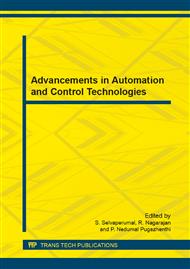p.13
p.19
p.26
p.31
p.35
p.40
p.46
p.52
p.59
Closed Loop Control of Positive Output Re-Lift Luo Converter with PSO and Cuckoo Techniques
Abstract:
Positive output Re-lift luo converter is a recently developed DC-DC converter which performs the conversion from positive source voltage to positive load voltage and are used in computer peripherals, dc drives, industries and other high voltage projects.Voltage lifting technique is employed and hence the output voltage increases in an arithmetic progression unlike classical boost converter. This paper presents the closed loop control of positive output re-lift luo converter with PI controller.PI controller is capable of providing good static and dynamic performances and can be used to analyze the system performance under disturbances.Control algorithm such as Cuckoo and Particle Swarm Optimization are implemented to track output voltage with respect to the reference voltage.These optimization techniques rejects the system disturbances at line and load side, hence steady state can be reached with less overshoot and settling time.The simulation model of the proposed converter is implemented in Matlab/Simulink and Cuckoo technique is compared over PSO.
Info:
Periodical:
Pages:
35-39
Citation:
Online since:
June 2014
Authors:
Price:
Сopyright:
© 2014 Trans Tech Publications Ltd. All Rights Reserved
Share:
Citation:


